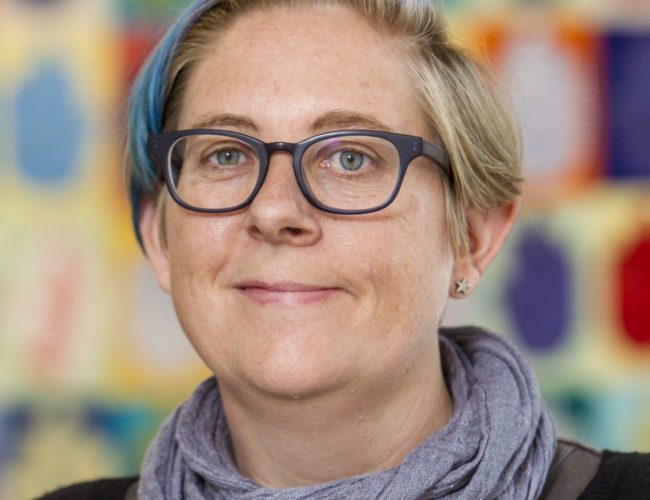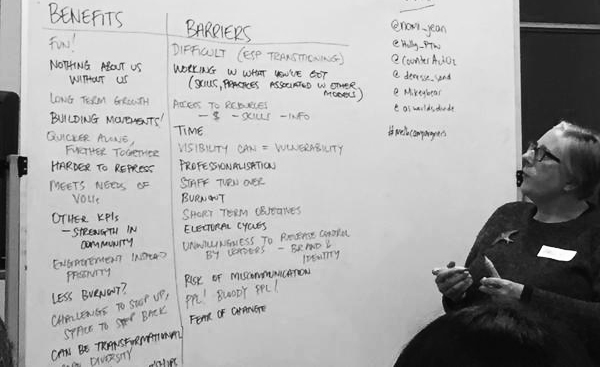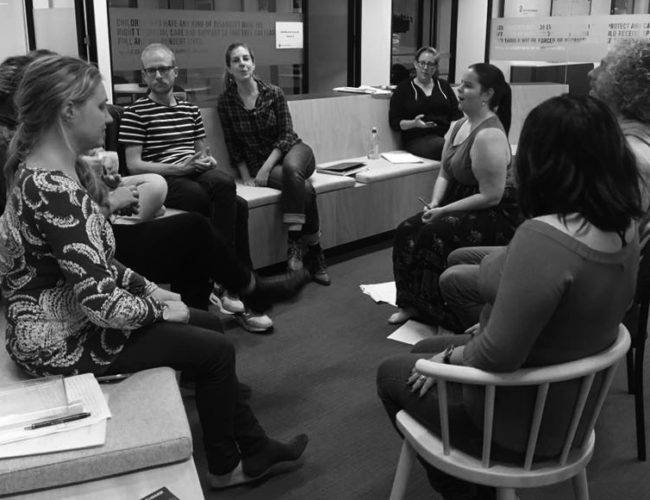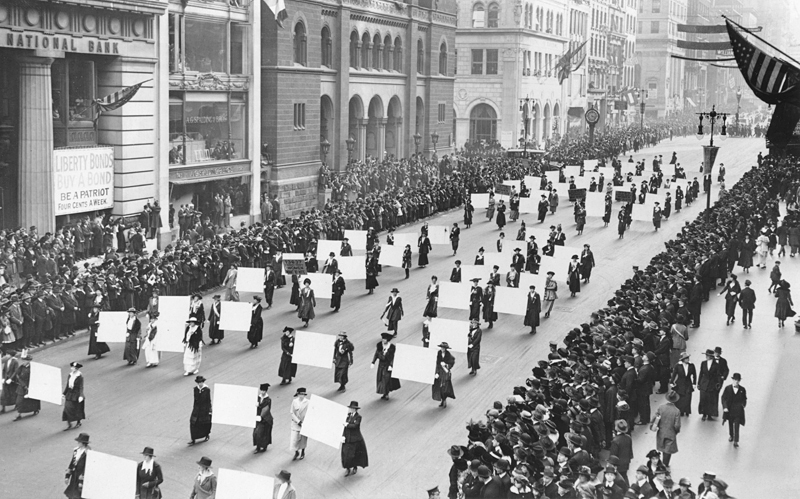The Ulex Project interviewed Plan to Win founder Holly Hammond. This article was originally published on the Ulex website in February 2018.
As an activist educator and mentor, Holly brings twenty-five years of experience of working across a variety of social movements. Since she became politically active at high school in the early 1990s, Holly has worked on youth rights, women’s liberation, sex industry law reform, labour rights, peace and environmentalism.
 Since 2005 Holly’s work has been primarily focused on supporting social movements. She ran a consultancy, worked with the Change Agency 2006–2011, established Plan to Win in August 2011, and more recently Plan to Thrive which focuses on activist sustainability and wellbeing. She has provided training and facilitation services for campaign organisations, from small grassroots groups to large NGOs, helping to build strong coalitions across our movements.
Since 2005 Holly’s work has been primarily focused on supporting social movements. She ran a consultancy, worked with the Change Agency 2006–2011, established Plan to Win in August 2011, and more recently Plan to Thrive which focuses on activist sustainability and wellbeing. She has provided training and facilitation services for campaign organisations, from small grassroots groups to large NGOs, helping to build strong coalitions across our movements.
As an activist and an educator, what value do you think training has within movement building?
Changing the world is a huge and challenging task and the people doing it need to have clarity and awareness in order to take it on. Any human endeavour requires people to learn, but especially so when some of the problems we’re facing we’ve never faced before. We therefore need people to be constantly innovating and improving on what we’ve done before. This means we need to be able to reflect upon our actions, learn lessons from them, and find new ideas and information to put into future actions. Activist education is a conduit for skilling people up to take on those challenges.
In the same way that corporations and government agencies train the people working for them to be better skilled at what they do, it’s very interesting that the work that I consider the most crucial – the work done by social movements – can be so under-resourced in terms of learning and development.
Is it something that’s already established in many activist cultures?
Learning has always been a part of social movements. So I guess it’s a question about whether it’s been given emphasis and visibility or whether it’s more so something that’s been going on behind the scenes and unacknowledged. Thinking back to myself when I first became an activist in my teenage years I did a lot of being thrown into the deep end but I also had people around me who were teaching me stuff all the time – providing practical tips and suggestions of ways to get connected with key people who could help me out with organising rallies and so on. So, informal passing on of information definitely happened. What I didn’t have a lot of access to as a young activist was formal training courses, to programmes I could go to that would develop my skills.
I remember my first contact with structured training was learning about NVDA, getting trained to go into a blockade. For the people who were offering the training it wasn’t their main job. It was just a small part of their lives added on to lots of other stuff they did. So for myself I never really saw activist education modelled in such a way that I thought you could prioritise it and make it your life’s work. Then, in 2005 I found out about Training For Change, a US training organisation. That was the catalyst for me. I read an interview with George Lakey – the founder of Training For Change – where he talked about this being his life’s work, and I had this kind of moment where I was like ‘that’s what I always wanted my life’s work to be about!’ I wanted to do it, but I never knew that I could. Finding out that other people were doing this work in earnest and making it their trade or career made it feel possible for me. It really helps to have those examples. What you’re offering with Ulex will be another beacon for people to know about this work and then to take it on.
How can trainings support our movements to grow more resilient?
In Australia we have a very small social movement support sector but it’s growing, and it’s become much more valued just in the last 5-10 years. This is because of shifts within social movements regarding the type of approach they want to take. If your theory of change is that you need to lobby the government to make it change then you only need a small handful of people, those meeting with politicians, to understand the dark art of lobbying. However, if your theory of change is that we need people power, then we find we need to continually grow a movement which brings in new people and creates escalating action. Training needs to be a part of that and you need to make it widely available.
There’s a cultural thing in many activist circles around working hard and putting all of yourself into things. A central aspect of activist identity is based around self-sacrifice. This can be a beautiful and powerful thing. But it can also be harmful. I think it’s possible we can shift that culture away from just working hard to being smart, being effective, being more powerful in the way that we act rather than necessarily just kind of treating ourselves like a resource to be used up. We need to move beyond bringing a kind of ‘extractivist’ approach to ourselves. It is possible that we can actually approach ourselves in a way that’s nurturing and about creating greater bounty.
What might be some of the ways we can do that?
The capitalist economy works to a model of boom and bust, and we’ve seen the devastating impacts of that. Activist cultures can try to find a healthier approach, working in such a manner that I do my work for social change, but I also nurture and replenish myself. This might look like a working week and a weekend off, or it may be more of an activist weekend and a weekday replenishment, or a period of high intensity campaigning for 6-9 months and then taking an extended break. However, we chose to do it, we can reconfigure our approach to activism so that it doesn’t have to be all or nothing. Speaking personally, I’ve been active for 25 years so there have been times when I’ve done more and times where I’ve done less. Now I’m striving for a way to sustain myself in the role I have as an activist educator, so that I can make a life-long commitment and be consistently available for this work.
How important are activist education spaces for supporting collaborative learning across different struggles?
One strand of my work is organising public workshops that are available to people across a broad range of different social movements. As well as being a networking opportunity we offer a short training session which might be exploring a campaign case study or a new area of innovation that people want to talk about. There is a real a mix at these events: Labour union folks alongside environmentalists; social justice and human rights advocates with animal rights activists; and both paid professional NGO workers and the grassroots DIY crew. It’s a powerful opportunity to bring people together across movements and different ways of working. We see people making different kinds of connections. Relationships strengthen and people are better able to work together.

For the changes we need to see in the world to happen, coalition building is vital. Most coalitions start through one-to-one relationships. Once there’s a common understanding between people you can build on that to align organisations more effectively. Another gain from shared learning spaces is the opportunity to just see things in a different way. A favourite instance of this is when we shared two different campaign case studies. One was a union that had run a powerful campaign around pay equity and the other was from a group that had been resisting the fossil fuel industry, who were completely unpaid. There was this great moment when the unpaid group were like ‘wow the amount of resources that you put into that campaign – you had three full time staff members working on it’. On the other hand, the union was able to go ‘wow look what you were able to achieve with so little and so much volunteer input’. So they were able to acknowledge that they were both operating in different ways, but that they could value what each other bring. From that acknowledgement they started cross-fertilising ideas.
What are some of the developments that you’re witnessing in activist education? Are there any particular areas of capacity building that you’re seeing met in new or fresh ways?
There are ongoing needs that I see across many different movements – skills development around building effective groups, communication skills, managing conflict, decision-making. There’s also the need for critical thinking around developing strategic capacity and campaign strategy, so that people are able to think bigger, analyse the problems they’re up against, and find the best ways to intervene. We also need to be able to grow our organisations and to be able to bring new people in, recruitment skills and the ability to fold them into the group.
We also need to develop leadership. Leadership is a vexed kind of concept in some activist circles, but I think it’s really crucial in terms of taking responsibility for making things go well. Every project is going to need those people who make a commitment and do their best to make things operate well. We need to be stepping people up to play that role in lots of different ways – and that requires the development of certain leadership skills.

Community organising has been a hot topic in Australia for a couple of years now, with people really wanting to grow the skills to be able to do that effectively. There’s a focus around directed network campaigning, and I’m wondering what is training going to look like that will enable people to be able to take that approach to campaigning? The NetChange report has been influential. – A bunch of campaigns were studied to look at what was most powerful and effective. They looked at campaigns where there was a central shared narrative or a brand that was picked up and rolled out in wider, dispersed way. So for example Black Lives Matter, which is both an identity and a movement, but it isn’t a controlled thing, with lots of different people and groups springing up all over the place doing BLM actions. That adds up to a lot of impact.
In Australia we have the ‘Lock The Gate’ campaign which is about resisting unconventional gas exploration and where we’ve had these gas-field free communities spring up. So there’s a model now for new groups to follow and get established, and with something that can be picked up by lots of different places and rolled out. Collectively it adds up to a lot more impact. But that’s where training comes in as well. So, for example you have one community group that’s done it, they’ve developed the model, and then they go to train the neighbouring community and share their learning there. This is where training comes in as a way to spread information and it’s a powerful tool.
Tell us a little bit about Plan To Win and Plan To Thrive.
I started Plan To Win in 2011. That’s the work that I do with facilitation, training and mentoring for social movements – training around campaign strategy, effective organising, building effective groups, and more. I do a lot of facilitation with groups around getting clear about your strategy, debriefing campaigns, and a lot of one-to-one work as well. Train trainers is a big focus for Plan to Win.
Later, I started Plan To Thrive with another colleague because we recognised a real need, a distinct need, around health and wellbeing. I now have two collaborators on that project – one focussing on doing an events calendar and one doing more work around blogging and seeding ideas to shift activist culture. I think it’s vital that we think about the different ways we learn and tend to that in a variety of ways.
In 2017 we held our first weekend activist wellbeing retreat, which was a bit of a cross-over between the two projects.
Historically what do we know about activist education within social movements? How central has it been to creating system change in the past?
Activist education has been around in a bunch of different ways for a long time. There’s a great book called ‘This is an Uprising’ by Mark and Paul Engler which is full of great social movement history and a lot of theory as well. They use examples of movements from different times including some great stuff around the civil rights movement, how well concerted their planning was, and how training was a vital part of that.
The world knows the story of Rosa Parks, that she was on the bus and she got tired and she sat down and refused to give up her seat. But prior to this Rosa had actually been a regular student at the Highlander Folk School, an amazing activist education centre in the States, where she had been trained in NVDA. The action she took was carefully planned, and it was just a question of the timing and when she would do it. It tells a good story that this action was almost a whim because people can connect with Rosa as a person, but this also means that you’re writing out the story of all that great planning and the training that went in beforehand.
‘This is An Uprising’ also unpacks the way that training was used within Otpor! – the movement that ousted Milošević in the late 1990s. This was also a directed network approach which brought a whole load of people in. It trained them up, sent them out, and set them up in a culture of organisation. It allowed and encouraged a bunch of scope for creativity to do what they wanted to do but to still use the brand.
There are so many examples of activist education, but it’s just whether they’ve been documented or not. The Trade Union movement has a long history of formalised training, including establishing significant movement infrastructure to support it. In Australia we had the Mechanics Institutes which were working class adult education set-ups which included political education. They did a whole bunch of training which helped people develop the skills to be advocates for each other and to work collectively. Those trainings have been going on for hundreds of years.
One case study I’d love to explore more is the First Wave women’s movement. This would have involved significant training – maybe it didn’t look like formal courses but was more so to do with the conversations they were having whilst they were making those awesome banners. If you look at photos of suffrage marches where they’re all so neatly lined up and walking with the same banners, you can see those actions have been completely choreographed, they’re designed to be media spectacles. There will have been hours of planning that went into that. There had to be training of the troops in order for people to have that discipline to operate in that way. (See the photo at the top of this page of the New York Suffragists Parade, October 23, 1915).
Training is a part of a long lineage within social movement building and has also been a key aspect of how innovation within social movements has spread. So, for example, the first protest tripod was constructed at an Australian forest blockade in 1989. This innovation was then picked up in forest activism in another country and then somebody else did it another context, adapting it to make it more effective for that particular struggle or setting. There were massive tripods at the Battle for Seattle, for example.
Actions are one way we build on ideas, share insights and strengthen relationships. The same goes for different forms of training. It’s important to remember the lineage that came before us. Let’s also remember the global weave that connects people around the world who are currently struggling, and the ways we better learn and figure out how we can make change happen, separately and together.
Learn more about Holly’s work at:
- Plan To Win – http://plantowin.net.au/
- Plan To Thrive – http://plantothrive.net.au
Further reading:
- Thank You Rosa Parks – info about the Highlander Folk School training http://www.williamlynn.net/guest-blog-thank-you-rosa-parks/
- This is an Uprising by Mark and Paul Engler http://thisisanuprising.com/
- Otpor! and their approach to training http://www.blueprintforrevolution.com/
- Plan To Thrive article by the Englers about activist burnout http://plantothrive.net.au/2015/02/map-ups-and-downs/
- Networked Change: How progressive campaigns are won in the 21st Century http://netchange.co/report
- Networked Agency: Lessons from the Australian Gasfields Free Movement by Annie Kia http://anniekia.net/

